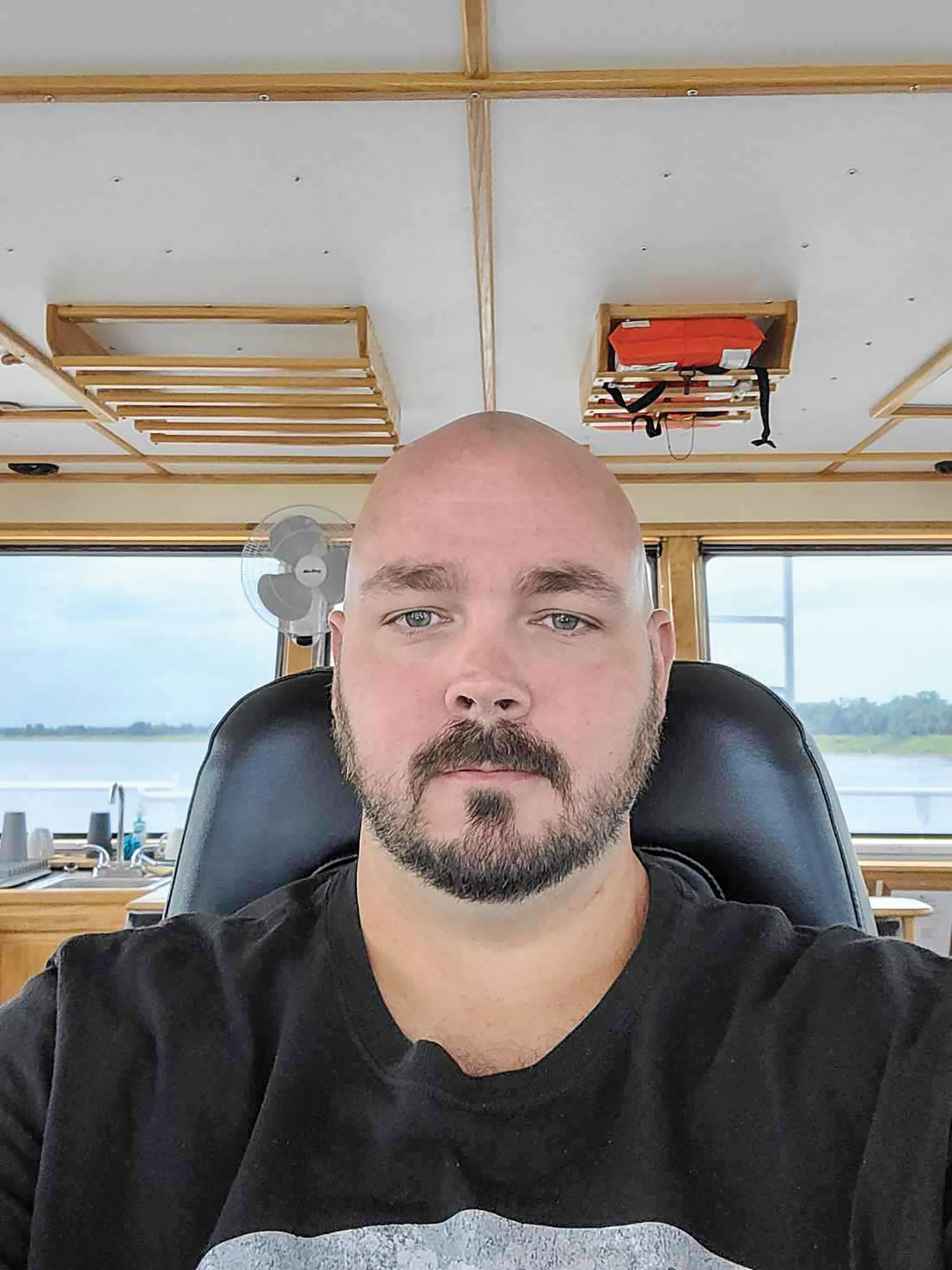Jared Lay, captain aboard Marquette Transportation’s mv. St. Simon, loves everything about being a towboat captain: the hard work, his crew mates, the craft of safely maneuvering a tow down the river and the daily tasks of learning, leading and teaching.
“I work 30 and 15, but there’s a lot of times I do ride over,” Lay said. “To be honest, I love my job.”
Lay got his start with Ingram after a friend from the military told him about his mother dispatching for the company. At the time, Lay had no idea what to expect, he said.
“I thought we were about to be doing some Deadliest Catch stuff,” Lay said.
Lay then moved over to AEP Gulf Operations, where he went from the deck to the wheelhouse. Early on, Lay worked under Capt. Howard “Slick” Dawsey Jr. at Dockside Fleet, then Capt. Denny Palmer at Convent Fleet. Those two captains in particular, Lay said, instilled in him a commitment to learning his craft and pursuing a career in the wheelhouse.
“Slick taught me about, if you want to be in the wheelhouse, you gotta go for it,” Lay said. “You can’t wait for anyone to give it to you.”
Palmer, Lay said, taught him the importance of good communication and being assertive, especially when underway.
“You have to let the other boats know what you need,” Lay said.
Lay started in AEP’s steersman program in 2011. When he moved over to Marquette in 2014, Lay started out first on the mv. Miss Roslyn, then on the Kieffer E. Bailey, where he served with Capt. Charles “Charlie” Waters.
“Since I’ve been with Marquette, I’ve been on more waterways than I could shake a stick at,” Lay said. “I have Charlie to thank for a ton of that experience.”
Lay said that, with Waters, piloting the boat wasn’t simply a matter of his watch and Waters’ watch. If Waters was scheduled to be on duty when the tow reached a difficult spot Lay hadn’t experienced yet, Waters would call him up to the wheelhouse to first observe, then pilot the boat himself.
“I remember my first time southbound through Vicksburg was going to be on his watch, and he asked me, ‘Do you want me to wake you up?’” Lay said.
More than a dozen years since moving into the wheelhouse, Lay still speaks of it in almost poetic terms. He compared piloting a tow around a bend to “great choreography, like ballet.”
“It’s nerve-wracking, but it’s fun at the same time, because you’re constantly learning,” Lay said. “Every day I’m out there, I’m gaining more experience. I was told by a captain that, if you ever get to the point you think you know everything, it’s time for you to walk away.”
For Lay, that sometimes means working a hitch on another boat to brush up on another river or canal system or “knock the rust off” his familiarity with conventional propulsion, since the St. Simon is a Z-drive. Flexibility is a good skill for any steersman, he said.
“If you make yourself knowledgeable in many areas, the company can use you anywhere they need you,” he said.
In the same way the captains early in his career mentored him, Lay works hard to teach his crew members and give them a vision for what the towboat and barge industry could mean for them. Lay said the first challenge he faces with new crew members is getting them to focus on the task at hand.
“When I was just starting on the deck, cell phones were there, but they weren’t huge,” he said. “The biggest thing nowadays is getting them to unplug from their cell phone.”
Lay said he makes a point to show green deckhands where a career in the maritime industry can take them, if they’re willing to work.
“I get them up to the wheelhouse their first day on the boat,” he said. “I tell them this is a career, not just a fly-by-night job. Once you pay your dues, you can really go places. The money we make coming from the deck to the wheelhouse is life-changing money, and it’s just about putting forth the work to get to that point.”
Lay said, when working with steersmen, he teaches them both how to steer by sight—learning to read landmarks and currents—and how to use radars and electronic charts.
Lay said family and friends back home provide him motivation for advancing in his career. He has three children at home, and he wants his dedication to excellence on the boat to be an example to them.
“I want to show them what hard work can do and what it can get you,” he said. “It’s a tough career. It’s time away from family and friends. There are sacrifices with this job. These days, my kids really keep me going.”



